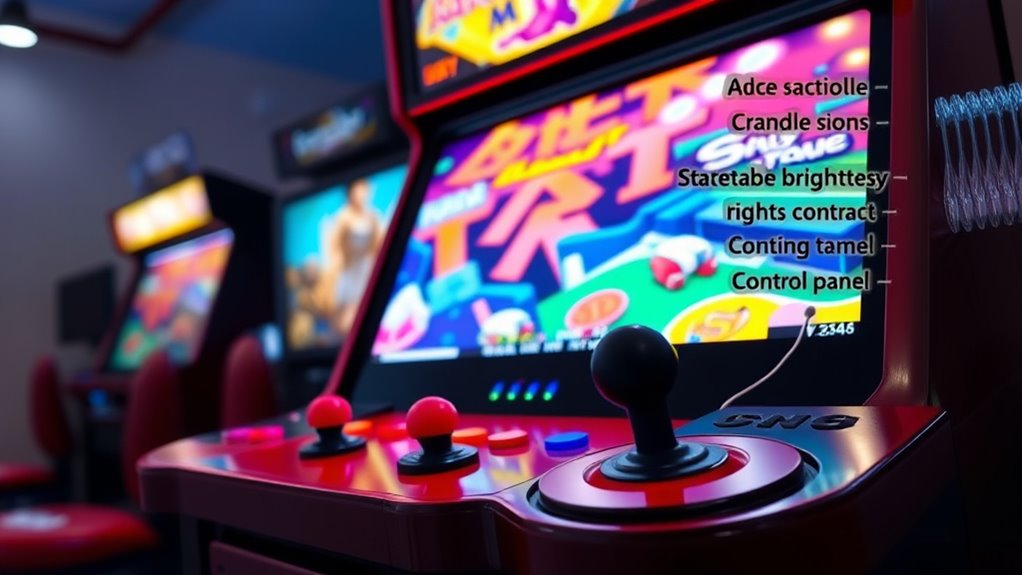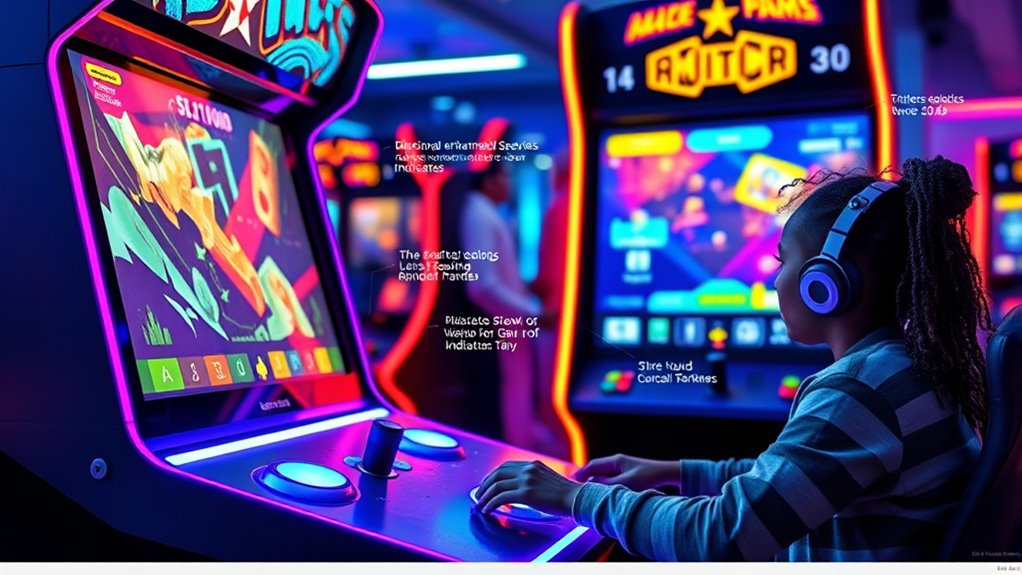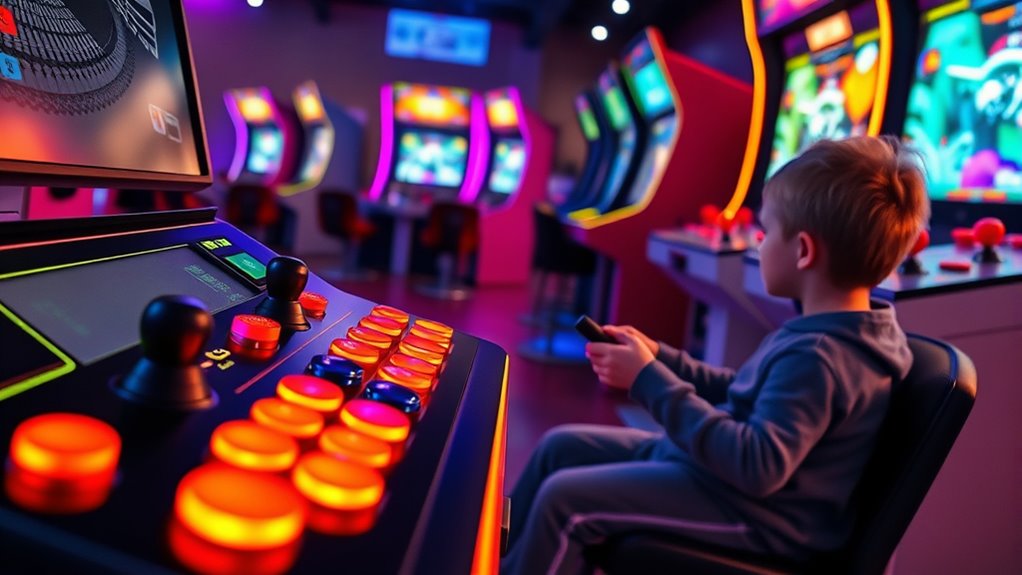Modern arcade games now include a variety of accessibility features to enhance your experience. You can use customizable controls like gesture inputs, tilt, or touch, making gameplay more intuitive. Visual options like high contrast, larger fonts, and color filters help if you have visual impairments. Audio cues with volume controls and vibrations support players with hearing difficulties. Plus, adaptive tech like voice commands and assistive devices offer even more inclusive ways to play. Keep exploring to discover how these features can improve your game.
Key Takeaways
- Modern arcade games incorporate customizable control schemes, including gesture controls and haptic feedback, to accommodate diverse player needs.
- They offer visual accessibility options like high-contrast modes, adjustable contrast, and larger text for better visibility.
- Sound customization and vibrational cues help players with hearing impairments or in noisy environments detect in-game events.
- Adaptive technologies such as voice commands, tactile devices, and screen readers enhance accessibility for players with disabilities.
- Inclusive design emphasizes clear color contrast, shape cues, and avoidance of color-only signals to ensure gameplay is accessible to all abilities.
Customizable Control Schemes and Input Methods

Because players have different physical abilities and preferences, modern arcade games increasingly offer customizable control schemes and input methods. You can now tailor your gaming experience with options like gesture controls, allowing you to use natural movements instead of traditional buttons. These controls make gameplay more intuitive and accessible for players with limited dexterity. Additionally, haptic feedback enhances immersion by providing tactile responses during gameplay, helping you feel more connected to the action. Whether you prefer swiping, tilting, or pressing buttons, these flexible input methods ensure you can play comfortably and effectively. By integrating gesture controls and haptic feedback, arcade games become more inclusive, allowing a broader range of players to enjoy the experience without sacrificing enjoyment or challenge. Accessible design plays a key role in making modern arcade games more welcoming for everyone.
Visual Accessibility Options for Better Clarity

Modern arcade games are increasingly incorporating visual accessibility options to help you see and interpret game elements more clearly. One key feature is enhanced visual contrast, which makes characters, objects, and backgrounds stand out against each other, reducing confusion. Adjustable contrast settings allow you to customize visuals for better clarity based on your preferences. Additionally, improving text readability is essential; options like larger fonts, high-contrast text, and simplified fonts ensure you can easily read instructions, scores, and menus during gameplay. These features reduce eye strain and make gameplay more accessible for players with visual impairments or sensitivities. By focusing on visual contrast and text readability, modern arcade games aim to create a more inclusive and enjoyable experience for everyone. Incorporating user-friendly controls further enhances accessibility, allowing players of all abilities to navigate game options with ease.
Auditory Enhancements and Alternative Sound Features

To guarantee everyone can enjoy the gaming experience, developers are adding auditory enhancements and alternative sound features. These improvements include clear, distinct audio cues that help players identify in-game events without relying solely on visuals. Sound customization options allow you to adjust volume levels, toggle specific sounds, or choose alternative audio profiles tailored to your needs. For example, you might increase alert sounds or enable vibrational feedback alongside auditory cues to better detect game prompts. By offering these features, developers ensure that players with hearing impairments or those in noisy environments can stay engaged and responsive. Additionally, ongoing research into AI safety measures emphasizes the importance of inclusive design in emerging technologies. These auditory enhancements create a more inclusive experience, making arcade games accessible and enjoyable for everyone, regardless of their hearing abilities or environmental challenges.
Adaptive Technology and Assistive Devices Integration

Integrating adaptive technology and assistive devices into arcade games enables a broader range of players to enjoy the experience fully. You can enhance gameplay with tools like:
- Voice command systems, allowing players to control games hands-free and circumvent physical limitations.
- Tactile feedback devices, providing physical sensations to confirm actions or alert players to in-game events.
- Custom controllers, tailored for different abilities to ensure comfortable and accessible play.
- Screen reading software, helping players with visual impairments navigate menus and game prompts more easily.
- Understanding contrast ratio helps in designing visual elements that are easier to distinguish for players with visual impairments.
Designing Inclusive Gameplay for All Abilities

Designing inclusive gameplay requires understanding the diverse needs of players with different abilities and intentionally creating experiences that accommodate them. You should prioritize clear color contrast to guarantee visuals are distinguishable for all players, especially those with color blindness. Use high-contrast color schemes to make text, buttons, and critical game elements stand out. Incorporate options for color adjustments or filters, allowing players to customize visuals to their needs. Avoid relying solely on color cues; add shapes, patterns, or labels to convey information. Additionally, considering accessible design principles can help ensure that game interfaces are user-friendly for individuals with varying physical and cognitive abilities. By considering these design choices, you create a more accessible environment where players with varying abilities can enjoy the game fully. Ultimately, inclusive gameplay invites everyone to participate and succeed, regardless of their visual or physical limitations.
Frequently Asked Questions
How Do Accessibility Features Impact Overall Game Performance?
Accessibility features can enhance your overall game performance by increasing game engagement and player retention. When you have options like adjustable controls or visual aids, you’re more likely to stay motivated and play longer. These features reduce frustration, allowing you to focus on gameplay and improve your skills. Ultimately, accessible design creates a more inclusive experience, helping you enjoy the game fully and encouraging continuous play.
Are There Costs Associated With Implementing Accessibility Options?
Think of adding accessibility options as planting seeds for inclusivity; it does require some investment. Implementing these features has cost implications, including development time and specialized equipment. However, this accessibility investment can broaden your audience and boost your reputation. While there are upfront costs, the long-term benefits often outweigh them, making your arcade more welcoming without draining your resources.
Can Accessibility Features Be Customized Individually for Each Player?
You can definitely customize accessibility features for each player, allowing individual customization based on player preferences. This means you can tailor controls, visual and audio options, or other settings to suit different needs. By doing so, you guarantee that each player has a more comfortable and inclusive gaming experience. Personalizing these features helps accommodate diverse abilities, making your arcade games more accessible and enjoyable for everyone.
How Do Developers Test Accessibility Features Effectively?
Testing accessibility features is like tuning a fine instrument—you need precision. You should involve diverse users, including those with disabilities, to see how the user interface adapts. Use hardware modifications to simulate different needs and gather feedback on ease of access. Iterative testing helps identify issues early, ensuring every player can enjoy the game. This hands-on approach guarantees your features are truly effective and inclusive.
What Future Innovations Are Planned for Arcade Game Accessibility?
You’re curious about future innovations in arcade game accessibility. Developers plan to enhance adaptive controllers further, making gameplay more inclusive. Voice recognition technology will become more sophisticated, allowing you to navigate menus and control games effortlessly. These advancements aim to break down barriers so you can enjoy arcade gaming regardless of physical abilities. Expect a more personalized, seamless experience that adapts to your needs, making gaming more accessible than ever before.
Conclusion
As you step into a world where every pixel and sound is crafted for inclusion, you can feel the thrill of gaming without barriers. Imagine a game that welcomes everyone’s unique abilities, where clarity cuts through the chaos and sound guides every move. By embracing these accessibility features, you’re not just playing—you’re opening doors for all to experience the magic of modern arcade games, creating a more inclusive, vibrant playground where everyone’s voice is heard and celebrated.








